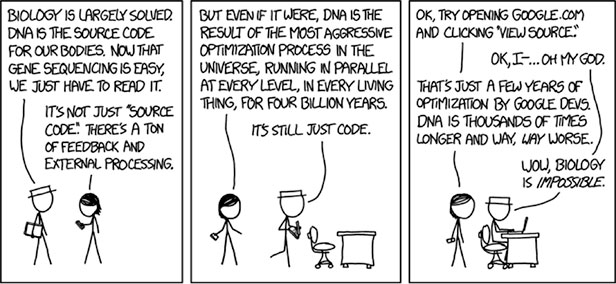Comic Explodes the “DNA Is Just Source Code” Metaphor
Randall Munroe, the polymath behind popular webcomic XKCD, is here with a reality check for everyone (myself emphatically included) guilty of trumping up the biotech revolution.
You know the rhetoric—DNA is just the alphabet of life, genes are just words, and now that we’ve figured out the language it’s time to start writing the next great biological novel! Or, if zeroes and ones are more your speed: “DNA is the source code.” So says Munroe’s stand-in for the slightly smug technophile who is sure “biology is largely solved” and that we can just read and rewrite it like any other coding language. Not so fast.

For folks who, like me, are coding neophytes, let’s elaborate a bit on the point about optimization; let’s go back to the literature metaphors. Think of DNA as a constantly edited manuscript. The vast majority of evolution is limited to working from the same document it started with. It can add to it, cross things out, rearrange the pieces, scribble notes in the margins, but there is no “undo” button. (To be fair, every now and then, mutation will introduce bits of totally fresh material—but it’s a total crapshoot. Like a cat periodically trotting across the keyboard.)
Imagine an MS Word document billions of pages long, edited by billions of different people over billions of years, and every single one of them had to leave track changes on. It’d make House of Leaves look like See Spot Run.
When faced with the messiness of real DNA, metaphors comparing genetics to a language (coding or literary) might be a bit too tidy. As my friend and former MIT Technology Review special projects editor Stephen Cass put it on Facebook: “Next time you read breathless headlines about how we’re (once again) on the cusp of a biotech revolution, think of today’s XKCD.”
In the breakneck world of biotech reporting, a bit of breath-catching never hurt anyone.
Keep Reading
Most Popular
Large language models can do jaw-dropping things. But nobody knows exactly why.
And that's a problem. Figuring it out is one of the biggest scientific puzzles of our time and a crucial step towards controlling more powerful future models.
How scientists traced a mysterious covid case back to six toilets
When wastewater surveillance turns into a hunt for a single infected individual, the ethics get tricky.
The problem with plug-in hybrids? Their drivers.
Plug-in hybrids are often sold as a transition to EVs, but new data from Europe shows we’re still underestimating the emissions they produce.
Google DeepMind’s new generative model makes Super Mario–like games from scratch
Genie learns how to control games by watching hours and hours of video. It could help train next-gen robots too.
Stay connected
Get the latest updates from
MIT Technology Review
Discover special offers, top stories, upcoming events, and more.